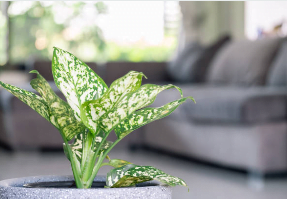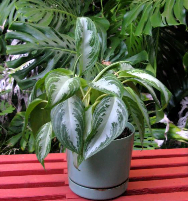Introduction
The Aglaonema, commonly known as the Chinese Evergreen, has long graced our indoor spaces with its lush green presence. Regarded as one of the most hassle-free and elegant houseplants, it can amplify the aesthetics of any room. This review delves into the comprehensive care and insights you need to make your Chinese Evergreen flourish. By the end of this guide, you’ll understand the intricacies of its care, from lighting needs to propagation techniques.
Aglaonema (Chinese Evergreen) Indoor Plant Details
| Specification | Details |
|---|---|
| Common Names | Chinese Evergreen |
| Botanical Name | Aglaonema |
| Family | Araceae |
| Plant Type | Herbaceous perennial |
| Mature Size | Typically 1-4 feet in height depending on the variety. |
| Sun Exposure | Low to medium, indirect light |
| Soil Type | Well-draining potting mix, enriched with compost or peat |
| Soil pH | Slightly acidic to neutral (6.1 to 7.5) |
| Bloom Time | Late summer to early fall, though it’s rare indoors |
| Flower Color | Generally white or pale green, though it’s grown primarily for its decorative leaves and not its flowers |
| Hardiness Zones | 10 to 12 (indoors can be kept in most zones) |
| Native Area | Southeast Asia, specifically the Philippines and parts of Malaysia |
Given the outlined specifications, potential owners of the Chinese Evergreen can gather a comprehensive understanding of the plant’s needs and characteristics. It’s crucial to remember that while the Aglaonema is appreciated for its beautiful foliage, providing it with the appropriate care conditions ensures it flourishes and thrives.
Plant Care:
When it comes to the Aglaonema, a little love goes a long way. It’s a plant that rewards care with vibrant foliage and a hearty presence. Familiarizing oneself with its needs can lead to a long-lasting bond with this indoor gem.
Light:
The Chinese Evergreen is versatile, thriving in varied light conditions. It prefers indirect, low to medium light. However, avoid placing it under direct sunlight, as this can scorch its leaves, leading to a lackluster appearance. For those living in apartments with limited natural light, rejoice! This plant will still thrive beautifully, making it a favorite for many urban dwellers.
Soil:
Opt for well-draining soil for your Aglaonema. A mix of potting soil, perlite, and sand works wonders. This combination ensures that the roots remain healthy and not waterlogged. A sign of good soil is when it retains moisture but doesn’t become overly saturated. Remember, a good foundation is key to the plant’s overall health.
Water:
Watering the Chinese Evergreen requires a balanced approach. While it doesn’t fancy its roots being drenched, it’s not a fan of complete dryness either. Water the plant when the top 1-2 inches of soil feel dry. Ensure that the pot has adequate drainage to prevent root rot. Using lukewarm water can also be a nice touch, especially during colder months.
Temperature and Humidity:
Native to tropical and subtropical regions, the Aglaonema enjoys warm temperatures and a humid environment. Aim for temperatures between 65°F to 80°F. If you live in a dry region, consider placing a humidifier near the plant or occasionally misting it. However, avoid extreme cold or drafts, as this can stress the plant.
Fertilizer:
Feeding your Chinese Evergreen ensures it receives all the nutrients it requires. Use a balanced, water-soluble fertilizer every 6-8 weeks during the growing season (spring and summer). In the dormant months (fall and winter), reduce the frequency. Always follow the manufacturer’s instructions and avoid over-fertilizing, as this can harm the plant.
Pruning:
Pruning not only maintains the Aglaonema’s shape but also promotes its health. Remove yellow or damaged leaves at the base to allow new growth. Regularly checking for any signs of pests or diseases during pruning can be a proactive step towards ensuring its well-being.
Overwintering:
While the Chinese Evergreen is an indoor plant, overwintering is essential if you’re in a region that experiences cold winters. Ensure it’s away from cold drafts or windows. Reduce watering during these months, and avoid fertilizing until spring returns.
Propagating Plant:
There’s joy in multiplying the beauty of the Aglaonema. Propagation is typically done through stem cuttings or by dividing the plant during repotting. When using stem cuttings, ensure you have a node, as this is where the new roots will sprout.
Quickly Declining:
Although a robust plant, there are signs that your Chinese Evergreen may not be at its best. Yellowing leaves, drooping, or signs of pests are indicators. Quick intervention, like adjusting watering or moving it to a more suitable location, can often restore its health.
Types of Plant:
The Aglaonema, or Chinese Evergreen, comes in a delightful variety of types, each boasting unique patterns and colorations on their leaves. Some popular types include:
- Aglaonema ‘Silver Queen’: Characterized by its silvery leaves adorned with a mix of green.
- Aglaonema ‘Red Gold’: Recognized by its luscious deep red and green leaves, adding a pop of color to any room.
- Aglaonema ‘Emerald Star’: Stands out with green leaves featuring a creamy white center.
- Aglaonema ‘Cutlass’: Has long, narrow leaves with a blend of silver and green.
The beauty of the Chinese Evergreen lies in its diversity, allowing enthusiasts to choose from a splendid palette of plants that resonate with their aesthetic.
- Aglaonema ‘Cutlass’: Has long, narrow leaves with a blend of silver and green.
Common Pests & Plant Diseases with Solutions:
Chinese Evergreen can be a target for several pests and diseases:
- Spider Mites: These tiny pests can cause yellow stippling on leaves.
- Solution: Wipe the undersides of leaves with a soapy water mixture and increase humidity.
- Mealybugs: Recognizable as small, cottony masses on the plant.
- Solution: Remove with a cotton swab dipped in alcohol or use insecticidal soap.
- Root Rot: Caused by overwatering, leading to a mushy base and yellowing leaves.
- Solution: Reduce watering frequency, ensure proper drainage, and consider repotting in fresh soil if the condition is severe.
- Leaf Spot Diseases: Manifest as dark spots on the leaves.
- Solution: Ensure the leaves remain dry, improve air circulation, and remove affected leaves.
Regularly inspecting your plant can help in early detection and intervention, ensuring your Chinese Evergreen remains vibrant.
How to Get Aglaonema (Chinese Evergreen) to Bloom:
While the Chinese Evergreen is primarily grown for its foliage, it can produce flowers under optimal conditions. To encourage blooming:
- Light: Ensure it gets consistent, indirect light.
- Feeding: During the growing season, feed the plant with a phosphorus-rich fertilizer.
- Consistent Care: Maintain regular watering and avoid extreme temperature fluctuations.
Remember, while the blooms are a delightful bonus, the primary charm of the Aglaonema lies in its foliage.
- Consistent Care: Maintain regular watering and avoid extreme temperature fluctuations.
Common Problems With the Plant:
Several problems can arise when caring for the Chinese Evergreen:
- Yellowing Leaves: Often a result of overwatering or using water with too many chemicals.
- Droopy Leaves: Usually due to underwatering or cold drafts.
- Brown Leaf Tips: Can be a sign of low humidity or excessive fertilizer.
- Pale Leaves: Indicate that the plant might be receiving too much light.
Observing your plant regularly and adjusting care based on its appearance and behavior is essential. With the right attention, the Chinese Evergreen can thrive and remain a radiant presence in your home.
This review on the Aglaonema showcases not just the plant’s mesmerizing beauty, but also its resilience and adaptability. It remains a top choice for indoor plant lovers, seamlessly blending aesthetics with easy care. Whether you’re a novice or an expert, the Chinese Evergreen promises a rewarding experience.
The Evergreen Verdict:
The Aglaonema, with its enchanting beauty and ease of care, is undeniably an indoor plant enthusiast’s delight. It not only brings greenery into your space but also a sense of tranquility. With the right care, it promises to be a loyal companion for years to come.
Frequently Asked Questions
Decode the magic of gardens with our guide to Landscaping Styles Frequently Asked Questions.
- Typically, every 2-3 years or when it outgrows its current pot.
- Yes, it can be toxic when ingested by pets, causing digestive distress. It’s best to keep it out of reach.
- This can be due to inconsistent watering or low humidity. Adjusting these factors can help.
- Yes, it can produce small flowers, but they’re often less noticeable compared to its vibrant foliage
Recent Posts
- Modern Mural Ideas Transforming Walls into Artworks
- Thematic Table Decor Dressing Your Table for Special Occasions
- Festive Lighting Ideas Brightening Your Home for the Holidays
- Biodegradable Decor Materials Choosing Earth-Friendly Options
- Personalized Space Decor Making Your Home Uniquely Yours
- New Year’s Eve Decor Ringing in the New Year in Style
- Transforming Junk into Decor Upcycling at Its Best
- Second-Life Decor Objects Giving Old Items New Purpose
- Unique Decoration Crafting Standout Ideas for Your Home
- Environmentally Friendly Styling Decor with a Conscience











